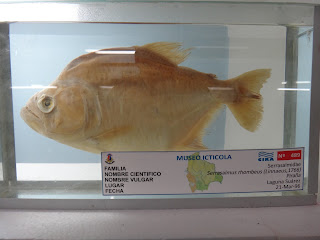While we've been waiting and waiting for our Interpol background check to come through, we've been both doing work and exploring what Trinidad has to offer. There are a few museums around town, one historical museum which never seems to be open, and two by the university campus a little way out from the center of town. We'd heard great things about the fish museum as being the third best in all of South America, so we hopped on a couple of moto taxis told them to take us there. Instead, they dropped us off at the Ethnoarcheological museum of the Beni (they must have known Asher was an anthropologist).
One of the really interesting parts of lowland Bolivia and particularly the Llanos de Moxos region is that it is the site of a famous pre-colonization population, whose population was estimated at being several hundred thousand people. This population is often referred to as the MoundBuilder Society. Work by scholars, such as Erland Nordenskiold, Metreux, Kenneth Lee, Willam Denevan, and Clark Erickson, have described how this population moved tremendous amounts of earth to create mounds, roads, canal and irrigation systems, and fish weirs. The primary reason why there was such an anthropogenic modification of the landscape was because of the heavy rains that the region gets during the rainy season. Interestingly enough, there is a large misconception that the Amazon region is a virgin landscape that wasn't modified before contact with the "Old World". However, this is simply not true. Humans have been living in this region for 10,000 plus years, and throughout this time they have been modifying the environment to suit their needs, whether that be building a dam in a stream, cutting a channel into a river to create a shortcut around a meander in the river, or using slash and burn agriculture to enrich the soil. Below you can see one of these mounds.
The museum also had some of the oldest archeological finds from the region, dated at more than 2000 years, including pottery that was used as storage containers for water and seed, ritualistic masks, and jewelry.
The fish museum had specimens of fish in formaldehyde as well as a small aquarium with live fish. Here's Asher at the entrance.
A very special type of small parasitic fish lives in some of the rivers of Bolivia. I'm referring to the so-called "penis" fish, which swims up the urine stream of humans when they urinate while in the water. Guess what Asher won't be doing in the river.
A larger version of the same family of penis fish.
The museum guide was really knowledgeable, but we got a kick out of how she, on multiple occasions, referred to how tasty the fish was and recommended that we find a restaurant that served it before leaving Bolivia. Here is the mighty (and tasty) pacu.
The famous pirana needs no introduction. Many of them are pretty small, but vicious.
And here is the river dolphin, a protected species in Bolivia. The river dolphins live in the Mamore River - the one that runs by Trinidad and is the largest Bolivian tributary to the Amazon River.
**SNAKE WARNING**
We've been asked by several people to give fair warning before posting any snake photos, so here it is.
**
This is the Beni anaconda who lives in this part of South America. The one in this picture is just a baby. We hope we don't see one of these in the river!
We also went to a local swimming area, called Laguna Suarez, about 12 km outside Trinidad. It's a man-made laguna where a lot of locals go. Several restaurants are waterside. Here are a few pictures, including a panorama.
Our friend, Noe Gaspard, a French linguist studying the Siriono language, took us to the Laguna.
We found our buddy, the 3-toed sloth, in the trees again when we were sitting in the plaza after lunch yesterday and snapped a couple more pictures. He doesn't have the prettiest face, but he's pretty cool and camouflaged well. We found out that the sloth doesn't actually live in the plaza. Zookeepers bring him to the plaza each morning and pick him up every night. We also learned that he is a she, and that she has a little baby sloth who hangs onto her belly as she moves through the trees.






















So interesting! Keeping fingers crossed and saying prayers that the Interpol background check comes through tomorrow!
ReplyDeleteI stumbled upon your blog while planning a Bolivia backpacking/pacrafting trip. Your blog is amazing! Looks like the trip of a lifetime. I have so many questions about the culture of the Tsimane and the Rio Maniqui. If you have time to correspond, it would mean the world to this fellow adventurer!:)) When will your research finish?? and will you publish your results?
ReplyDelete